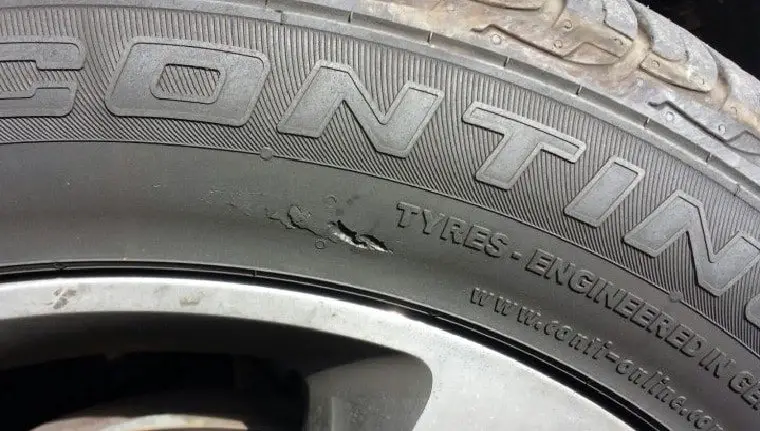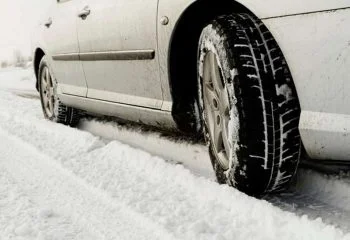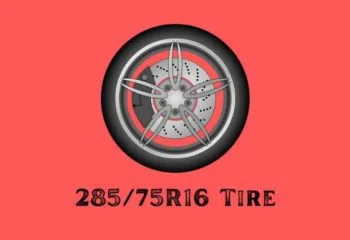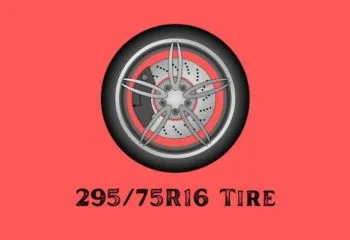Chances are you have seen tire sidewall damage, even if you don’t know what it is called. This type of damage is caused when the outer edge of the tire comes into contact with a hard object, such as a curb or pothole.
While it can be repaired, if left untreated it can lead to bigger problems down the road. So, what should you do if you see sidewall damage on your tires?
In this blog post, we will discuss what tire sidewall damage is, what is the causes and how to tell if it is too much. We will also provide tips on how to prevent sidewall damage. Keep reading to find out.
What's in this post?
What is a tire sidewall and what does it do for your car tires
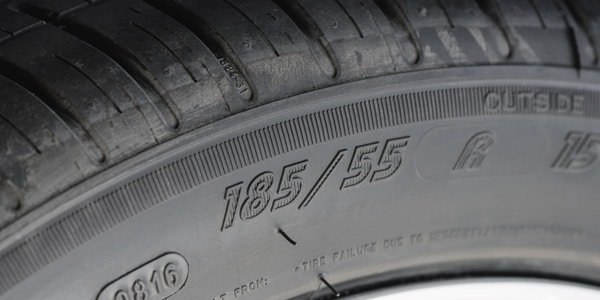
The sidewall of a tire is the portion that extends from the edge of the tread to the bead, where the tire meets the wheel.
The sidewall is responsible for protecting the inner components of the tire, as well as absorbing shocks and other impacts.
In addition, it provides reinforcement against centrifugal forces, helping to keep the tire in contact with the road. The sidewall also plays an important role in determining a tire’s rolling resistance, which can impact fuel economy.
As a result, it is important to choose a tire with a sidewall that is appropriate for your driving needs.
What is sidewall damage and why it should be fixed as soon as possible
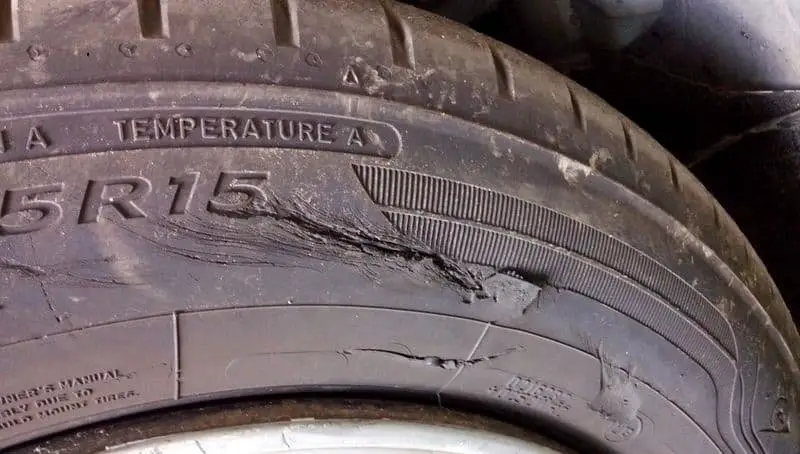
Sidewall damage refers to any damage that occurs to the sides of your car. This can include scratches, dents, or even cracks.
While sidewall damage may not seem like a big deal, it can actually lead to a number of serious problems.
First, sidewall damage can weaken the structure of your car, making it more susceptible to collisions.
Additionally, sidewall damage can also cause tire pressure problems, which can lead to a blowout.
Finally, sidewall damage can also make your car more difficult to control.
For all these reasons, it is important to have any sidewall damage fixed as soon as possible.
What is considered sidewall damage on a tire?
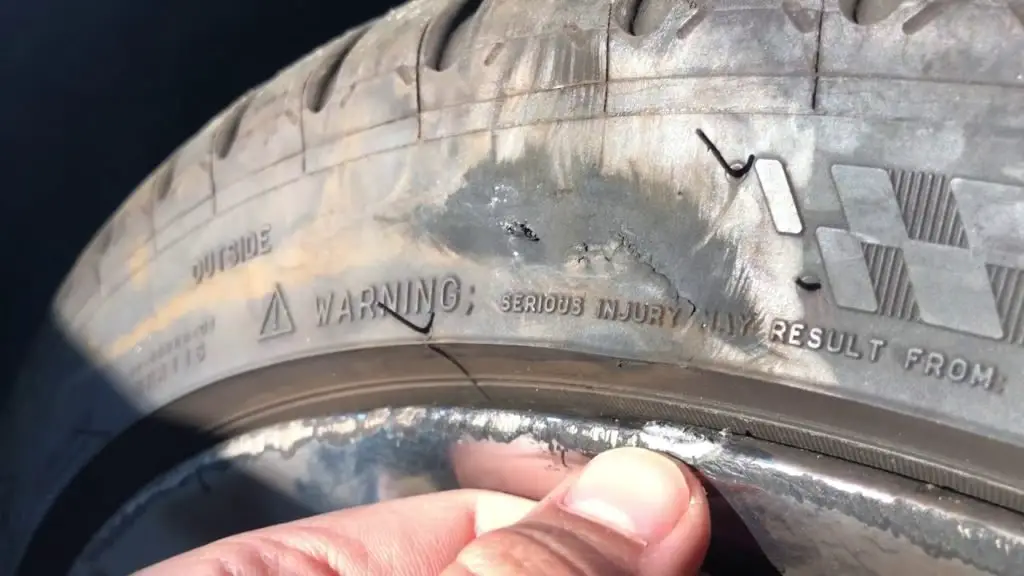
There are several different types of sidewall damage, each with its own set of symptoms. Here are some of the most common types of sidewall damage:
Nail in tire sidewall/Puncture
A puncture is one of the most common types of sidewall damage. It is caused when a sharp object, such as a nail, penetrates the tire and causes a hole.
Symptoms of a puncture include a sudden loss of air pressure, as well as a hissing sound when the tire is in use.
If you notice either of these symptoms, it is important to have the tire inspected by a professional as soon as possible.
Missing chunks of tire sidewall
Another common type of sidewall damage is missing chunks of tire. This can be caused by a number of different things, including driving over potholes or hitting curbs.
Missing chunks of tire will cause the tire to lose air pressure and can also lead to a blowout.
If you notice any missing chunks of tire, it is important to have the tire inspected and repaired as soon as possible.
Ripped surface layer
The surface layer of the sidewall is what gives the tire its smooth, finished look. However, this layer can become ripped or torn, exposing the inner layers of the tire.
This can happen if you drive over a pothole or hit a curb. Ripped surface layers will cause the tire to lose air pressure and can also make the tire more susceptible to punctures.
If you notice a ripped surface layer, it is important to have the tire repaired as soon as possible.
Wear and abrasions
This type of damage is usually caused by driving on rough roads or using tires that are not properly inflated.
Over time, the constant contact with the road surface can wear down the sidewalls of the tires, exposing the inner layers of rubber.
In some cases, this can lead to punctures or even blowouts. To help prevent this type of damage, it is important to inspect your tires regularly and be cautious when driving on rough roads.
Sidewall bubble
A sidewall bubble is a condition that can occur in tires when the inner layer of the tire is damaged. This damage can be caused by a number of factors, including hitting a curb or pothole, over-inflation.
When a sidewall bubble forms, it causes the tire to bulge outwards, which can affect the tire’s ability to grip the road and can lead to a blowout.
Sidewall bubbles are usually visible on the outside of the tire, and they can range in size from small to large. If you suspect that your tire has a sidewall bubble, take it to a qualified mechanic or tire dealer for inspection.
What cause tire sidewall damage
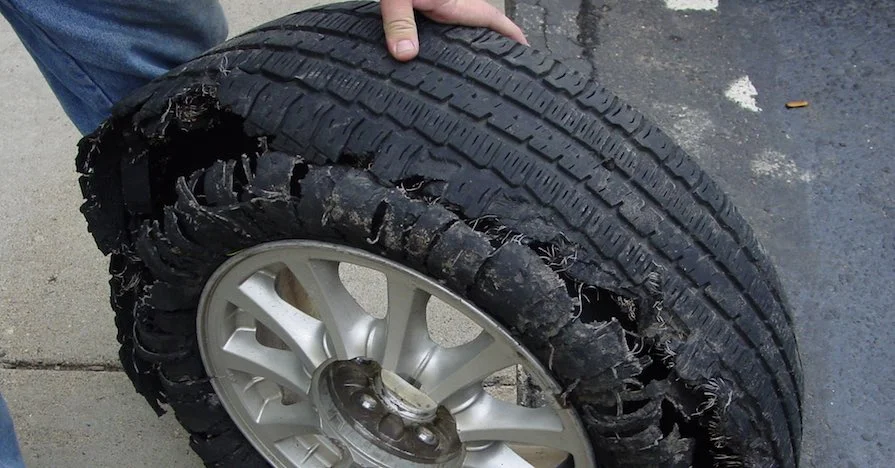
Hitting a curb, pothole, or other object
One of the most common causes of sidewall damage is hitting a curb, pothole, or sharp objects.
When you hit something with your tire, it can cause the sidewall to flex and bend, which can lead to cracks, punctures, or even blowouts.
To help prevent this type of damage, it is important to be cautious when driving and avoid hitting curbs, potholes, or other objects.
If you do hit something, it is important to have your tire inspected by a professional as soon as possible.
Over-inflation
Another common cause of sidewall damage is over-inflation. When a tire is inflated to too high of a pressure, it can cause the sidewall to bulge and deform.
This can lead to cracks, punctures, or even blowouts. To help prevent this type of damage, it is important to check your tire’s recommended inflation pressure and stick to that number.
It is also important to check your tires regularly for any signs of over-inflation.
Under-inflation
Just as over-inflation can cause sidewall damage, under-inflation can as well. When a tire is under-inflated, the sidewall will flex and bend more than it should.
This can lead to cracks, punctures, or even blowouts. To help prevent this type of damage, it is important to check your tire’s recommended inflation pressure and stick to that number.
It is also important to check your tires regularly for any signs of under-inflation.
Wear and tear
Over time, the constant contact between your tires and the road will cause the sidewalls to wear down. This wear and tear can lead to cracks, punctures, or even blowouts.
To help prevent this type of damage, it is important to inspect your tires regularly for any signs of wear and tear. If you notice any damage, it is important to have the tire repaired or replaced as soon as possible.
Age/Overuse
As tires age, the sidewalls can become brittle and more susceptible to damage. This type of damage is often caused by weathering and exposure to the elements. It can also be caused by overloading the tires or driving on rough roads.
If you have tires that are over 5 years old, it’s a good idea to have them inspected by a professional to check for sidewall damage. Even if the tires look fine on the outside, they may be starting to degrade on the inside, which can lead to a blowout.
Manufacturing defects
In some rare cases, manufacturing defects can cause sidewall damage. This type of damage is often not covered by warranty.
If you suspect that your tire has a manufacturing defect, it is important to take it to a qualified mechanic or tire dealer for inspection.
How can you tell if sidewall damage is too much?
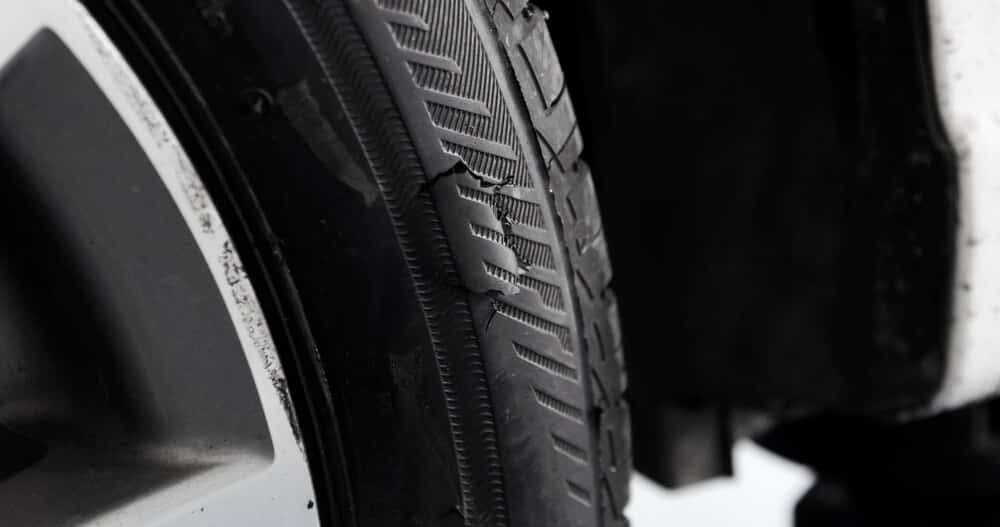
If you take a close look at your tires, you’ll notice that the sidewalls are made up of several different layers. The outermost layer is the tread, which is what comes into contact with the road.
Underneath the tread is the belt, which helps to reinforce the tread and prevent it from becoming worn down too quickly.
Finally, the innermost layer is the carcass, which gives the tire its shape and strength.
Sidewall damage can occur at any of these levels, but it is most serious when it affects the carcass. If the carcass is damaged, it can cause the tire to lose its shape and eventually fail.
There is no set amount of damage that is considered too much, as it depends on the severity of the damage and the type of tire.
Unlike other tire damage, most sidewall damage can’t not be repaired, except puncture. The sidewall is an essential part of the tire, and once it is damaged, the tire must be replaced.
The sidewall is what provides the structure for the tire, and once it’s damaged, it can’t hold air. In addition, sidewall damage can weaken the tire and make it more susceptible to further damage.
As a result, it’s important to be careful when driving on roads with debris or potholes. If you do hit something, inspect your tires immediately for any signs of damage.
How to avoid tire sidewall damage in the future
There are a few things you can do to help prevent sidewall damage in the future:
Inspect your tires regularly: It is important to check your tires regularly for any signs of wear and tear. If you notice any damage, it is important to have the tire repaired or replaced as soon as possible.
Check your tire pressure: Checking your tire pressure is one of the best ways to prevent sidewall damage. Make sure to check your tires’ recommended inflation pressure and stick to that number.
It is also important to check your tires regularly for any signs of over-inflation or under-inflation.
Avoid driving on rough roads: Driving on rough roads can cause the sidewalls of your tires to become damaged. If possible, try to avoid driving on roads that are in poor condition.
If you must drive on a rough road, slow down and be careful to avoid any potholes or other obstacles.
Replace old tires: As tires age, they can become more susceptible to damage. If you have tires that are over 5 years old, it’s a good idea to have them inspected by a professional to check for sidewall damage.
Even if the tires look fine on the outside, they may be starting to degrade on the inside, which can lead to a blowout.
Be mindful of your driving: reckless or aggressive driving can cause the sidewalls of your tires to become damaged. Try to avoid sudden acceleration, braking or turning.
If you must make a sudden move, do it slowly and carefully to avoid putting too much stress on the tires.
FAQs about Tire Sidewall Damage
Can you patch the sidewall of a tire?
Yes. It is possible to patch a tire sidewall if the damage is due to a puncture. If the sidewall is damaged in any other way, however, the tire will need to be replaced.
When patching a tire, it is important to use a high-quality. Patch kit containing patches that are specifically designed for tire sidewalls.
Otherwise, the patch may not adhere properly and could eventually come off, leading to further damage. It is also important to make sure that the area around the puncture is clean and dry before applying the patch.
If the sidewall is damaged in any other way, such as by a cut or abrasion, it will not be possible to patch it and the tire will need to be replaced.
Can I drive on a tire with sidewall damage?
While it is technically possible to drive on a tire with sidewall damage, it is not recommended. Sidewall damage can weaken the structure of the tire, making it more susceptible to blowouts and other failures.
In addition, damaged tires may not provide the same level of handling and traction as undamaged tires. As a result, driving on a tire with sidewall damage can be dangerous.
If you must drive on a damaged tire, make sure to check the pressure regularly and avoid driving at high speeds. If possible, replace the tire as soon as possible.
Do tire warranties cover sidewall damage?
Most tire warranties do not cover sidewall damage. This is because sidewall damage is usually caused by driving on a flat tire or by hitting a curb. As a result, it is not covered by most tire warranties.
However, some tire manufacturers offer separate sidewall damage insurance policies. These policies typically have a deductible and may only cover certain types of damage.
For example, they may exclude damage caused by nails or other objects puncturing the tire. Before purchasing a sidewall damage insurance policy, be sure to read the fine print and understand what is and is not covered.
Can you fix a sidewall puncture on a tire?
Yes, if you’re lucky, the hole will be small and you’ll be able to patch it up with a tire patch kit. If the hole is bigger, you might need to replace the tire.
How thick is the sidewall of a tire?
The sidewall of a tire is typically about 2-4 millimeters thick. However, the exact thickness will vary depending on the type of tire.
Can I replace just the sidewall of a tire?
No, you cannot replace just the sidewall of a tire. The entire tire must be replaced if the sidewall is damaged.
Should I remove the nail from my tire?
If you find a nail in your tire, it is important to take action right away. If the nail is left in while the tire is running, it can cause the tire to puncture more.
The best thing to do is to remove the nail and take the tire to a professional to have it inspected.
Is it better to patch a tire or plug it?
When you get a flat tire, you have two options for fixing it: patching or plugging. Both methods have their pros and cons, so it’s important to choose the right one for your situation.
Patching involves applying a new piece of rubber over the hole in the tire. This is a permanent fix that will prevent further air leaks.
However, it can be difficult to properly apply a patch, and it may not adhere correctly if the hole is too large.
Plugging involves inserting a plug into the hole in the tire. This is a temporary fix that will need to be replaced eventually.
However, it is much easier to do than patching, and it can be used on tires with larger holes. When deciding whether to patch or plug a tire, consider the size of the hole and your own level of expertise.
If you’re not confident in your ability to properly patch a tire, then plugging may be the better option.
Can you plug a hole in the sidewall?
Yes, you can plug a hole in the sidewall of a tire. However, it is not recommended. This is because the sidewall is the weakest part of the tire, and any plugs or patches will only be temporary fixes.
Over time, the hole will re-open and the tire will be at risk for further damage. Additionally, plugs or patches can cause the tire to lose air pressure more quickly, which can lead to a blowout.
If you have a hole in your sidewall, it is best to replace the tire as soon as possible.
How close to the sidewall of a tire can you plug?
The puncture must be at least 1/2 inch away from any edge on your tire where its internal steel belt starts. If it’s less than this distance, then there is no way to get repairs done and you’ll need new tires!
How does a nail get into the sidewall of a tire?
There are a few ways that nails can get into the sidewall of a tire. The most common is by driving over a nail or other sharp object.
Another way is by hitting a curb, which can cause the tire to rub against the asphalt and expose the sidewall.
Nails can also get into the sidewall through cracks or holes in the rubber. This is more likely to happen if the tire is old or has been damaged previously.
How do I know if my sidewall is damaged?
There are a few signs that your sidewall may be damaged. You may notice that your tire is leaking air more quickly than usual.
You may see cracks or cuts in the sidewall. Finally, the tire may feel unbalanced or wobble when you drive. If you notice any of these signs, it is important to take your car to a mechanic as soon as possible.
Is it safe to drive on a tire with a chunk missing?
It is generally not safe to drive on a tire with a chunk missing. While the tire may still be able to hold air, the missing piece can weaken the structure of the tire and cause it to fail while in use.
Even if the tire doesn’t fail outright, the chunk missing can throw off the balance of the tire, causing vibration and making it more difficult to control the vehicle.
For these reasons, it is best to replace a tire with a chunk missing as soon as possible. If a new tire is not immediately available, driving at reduced speeds and avoiding highways is recommended.
Is sidewall damage illegal?
Sidewall damage is not illegal as long as there is still 1.6mm of tread depth across the center 3/4 of the width of the tread throughout the entire circumference of the tire.
However, if there is any damage to the tire body – sidewalls or tread, bulges or cuts – this may make the tire illegal. If you are unsure whether your tire is legal, it is best to get it checked by a professional.
Driving on an illegal tire is punishable by a fine of up to $2,500 and 3 points on your license. It can also invalidate your car insurance.
Final thoughts
If you are ever in doubt about the severity of tire sidewall damage, it is always best to play it safe and take them to a professional. Trying to drive on severely damaged tires can be dangerous for you and other drivers on the road.
Not only could driving on them cause more damage, but it also puts you at risk of getting pulled over or in an accident. Always err on the side of safety when it comes to your car and its components. Have you had experience with sidewall damage? What did you do?

